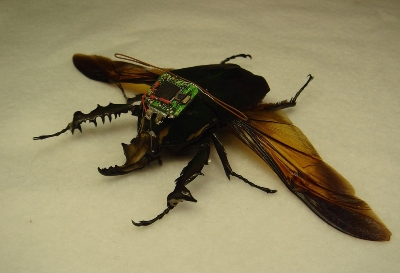Science writer Emily Anthes has a new book out that covers all the ways we’re tinkering with animals and turning them into cyborgs, ready to obey our every whim. And, she reports, we’ve gotten a lot better at this in the past few decades.
Back in the 1960s, for example, government scientists decided they would wire up a cat and train it to sit near diplomats, recording their conversations. They put a microphone in the cat’s ear and a radio transmitter in her head. Then they sent her out in the field, and you can guess how well that went:
[The CIA’s] robo-cat didn’t seem terribly interested in national security. For its first official test, CIA staffers drove Acoustic Kitty to the park and tasked it with capturing the conversation of two men sitting on a bench. Instead, the cat wandered into the street, where it was promptly squashed by a taxi. The program was abandoned …
Now, though, the government has gotten wise and realized it should probably start by wiring up creatures not known for their insouciance and defiance. To begin with, DARPA has settled on bugs. Anthes writes:
What the agency wanted was a remote-controlled bug that could be steered to within five meters of a target. Ultimately, the insects would also need to carry surveillance equipment, such as microphones, cameras, or gas sensors, and to transmit whatever data they collected back to military officials. The pamphlet outlined one specific application for the robo-bugs — outfitted with chemical sensors, they could be used to detect traces of explosives in remote buildings or caves …
The amazing thing about this idea is that it actually has a strong chance of being made real. One scientist has already figured out how to control the flight of a beetle. He isolated the area of its brain that controlled its flight, then wired up its brain and muscles. Here’s how that went:
Then it was time for a test flight. One of Maharbiz’s students called up their custom-designed “Beetle Commander” software on a laptop. He issued the signal. The antennae jutting out of the beetle’s backpack received the message and passed it along to the circuit board, which sent electricity surging down the wire and into the beetle’s optic lobe. The insect’s wings began to flap. The empty white room the researchers used as an airfield filled with a buzzing sound, and the bug took flight. The beetle flew on its own — it didn’t need any further direction from human operators to stay airborne — but as it cruised across the room, the researchers overlaid their own commands. They pinged the basalar muscles, prompting the beetle to weave back and forth through the room, as if flying through an invisible maze. It wouldn’t have looked out of place going up against a stunt pilot at an air show. Another jolt of electricity to the optic lobe, and the beetle dropped out of the air and skittered across the tile floor.
Where it was run over by a taxi. Just kidding. Where it was retrieved and celebrated as the best chance the military has at sending actual bugs out in the field to spy on people.




